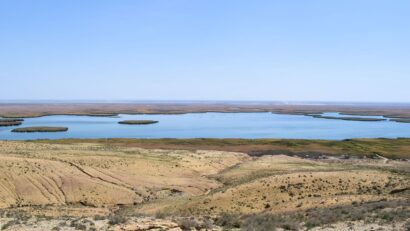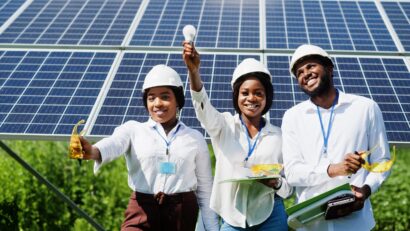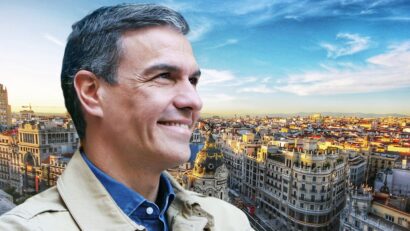
3 Cars, 22 Families: Rural Carsharing That Works
In the Bavarian village of Amerang, distances are long and buses rarely run. So, is it possible to live in Läs mer…
Nyheter och länkar - en bra startsida helt enkelt |Oculus lyx vitae

In the Bavarian village of Amerang, distances are long and buses rarely run. So, is it possible to live in Läs mer…

The British city of Bradford proves that environmental protection benefits both public health and the economy. Since introducing its Clean Air Zone (CAZ) in 2022, the city has significantly improved air quality. The results speak for themselves: a 25% drop in doctor visits and annual healthcare savings exceeding €420,000.
Bradford Redefines Traffic Rules in Its Clean Air Zone – The Result: Cleaner Air and More Funding for Climate Action
When the English city of Bradford in Yorkshire introduced one of the country’s largest low-emission zones in 2022, reactions were mixed. Critics feared economic drawbacks, while supporters hoped for cleaner air and fewer health issues.
Two years later, a new study confirms the positive impact. The 22.4-square-kilometer Clean Air Zone (CAZ) is saving the UK’s healthcare system approximately £30,700 per month—more than €35,000 per month or €420,000 per year. According to the Bradford City Council, air pollution levels in the city are now the lowest ever recorded. Nitrogen dioxide levels have dropped, and doctor visits for respiratory and cardiovascular diseases have declined by 25 percent, amounting to 732 fewer medical appointments per month. This, in turn, helps to relieve pressure on the city’s overburdened emergency rooms and clinics.
What is particularly noteworthy is that the improvements extend beyond the Clean Air Zone itself. Many residents have upgraded to cleaner vehicles, leading to better air quality across the city. One striking example is Bradford’s taxi fleet, which is now the cleanest in the entire United Kingdom.
Who Has to Pay to Drive in the Clean Air Zone?
The CAZ regulates the use of older, high-emission buses, trucks, and taxis. These vehicles must either pay a daily fee or avoid the zone altogether:
•£50 (€58) per day for buses and trucks
•£9 (€10.50) per day for vans and minibuses
•£7 (€8) per day for taxis
Private cars and motorcycles are exempt from the charges.
Taxis, trucks, and commercial vehicles must pay fees to drive within Bradford’s Clean Air Zone. (Photo: Samuel Regan-Asante/Unsplash)
Investing in Cleaner Transportation
The revenue generated from these fees is reinvested directly into air quality improvement projects. The funds are used to modernize public transport, including upgrading to cleaner buses and introducing new electric vehicles on high-traffic routes. Taxi companies receive financial support to transition to low-emission vehicles, while businesses are offered grants to replace outdated, polluting vehicles.
Why Is Bradford’s Clean Air Zone More Effective Than London’s?
There are now more than 300 low-emission zones across the UK and Europe, but not all have been as successful as Bradford’s. In London, the Ultra-Low Emission Zone (ULEZ) was expanded to cover the entire city in August 2023, sparking widespread protests. The key difference is that London’s ULEZ also targets private cars that do not meet the latest emission standards, placing financial strain on many households.
Bradford took a different approach. The city actively supported businesses in transitioning to cleaner vehicles before the zone was implemented. The CAZ was also designed with social fairness in mind. Low-income communities are often the most affected by air pollution, despite contributing the least to it.
A study confirms this impact. “20% of the city population live inside the zone. These families tend to be the poorest, and most likely to suffer ill health. They are also less likely to cause pollution in the first place”, explains study leader Rosie McEachan.
This work is licensed under the Creative Common License. It can be republished for free, either translated or in the original language. In both cases, please cite The Better News / Sophie Wenkel as the original source/author and set a link to this article on TheBetter.news. https://thebetter.news/bradfords-clean-air-zone/
The rights to the content remain with the original publisher. Läs mer…

The Aral Sea was once one of the largest lakes in the world. But within just a few decades, human actions nearly dried it up. The surrounding regions in Uzbekistan and Kazakhstan have faced drought, soil salinization, and severe sandstorms. However, in recent years, international cooperation has given the Aral Sea a second chance. Large-scale water redirection, resilient vegetation, and a dam are driving the Aral Sea recovery.
Until the mid-20th century, the Aral Sea was the fourth-largest lake on Earth, covering 68,000 square kilometers—roughly the size of Ireland. But in the 1960s, disaster struck. The Soviet Union redirected the Amu Darya and Syr Darya rivers to irrigate vast cotton and rice fields. Without these rivers feeding it, the Aral Sea began to shrink rapidly. By the 1970s, it had already lost a significant amount of water. Today, only 10% of its original surface remains, while the Aralkum Desert has taken its place, growing to 62,000 square kilometers. This expanding desert brings extreme heat, salty soil, and dangerous sandstorms.
A Chain Reaction of Devastation
As the lake dried up, its remaining water became saltier, killing off most fish and plant life. Without the sea acting as a temperature regulator, summers now reach over 42°C, while winters are bitterly cold. A layer of salt formed on the exposed lakebed, preventing new plant growth. Strong winds lift this salt and sand into the air, spreading toxic dust laced with pesticides from old agricultural runoff. These storms have harmed human health and ecosystems across vast distances, even burying entire villages in sand.
[embedded content]
A Global Mission for Aral Sea Recovery
The water supply of the region depends on two major rivers: the Amu Darya, which flows through Tajikistan, Uzbekistan, Turkmenistan, and Afghanistan, and the Syr Darya, which runs through Kazakhstan, Tajikistan, and Uzbekistan. With many Central Asian nations struggling with water shortages, international cooperation has become essential.
Since 2017, organizations such as the International Fund for Saving the Aral Sea and the Interstate Commission for Water Coordination in Central Asia have worked to manage water resources. In January 2025, a summit in Dushanbe, Tajikistan, resulted in a major agreement: Kazakhstan will receive 11 billion cubic meters of water through pipelines, with 1.6 billion cubic meters flowing directly into the Aral Sea by spring 2025.
Kazakhstan had already redirected 2.6 billion cubic meters of water to the Aral Sea in 2024. For comparison, in 2022, the amount was just 816 million cubic meters.
Saxaul Shrubs: Nature’s Answer to Desertification
To combat desertification, efforts have focused on reforesting parts of the former lakebed. Since 2021, the “Oasis” project, supported by U.S. development funds, has been planting saxaul shrubs on 500 hectares of land. These tough plants have deep roots that can hold up to 4,000 kilograms of sand, helping to stabilize the soil.
Unlike most vegetation, saxaul shrubs thrive in salty and arid conditions. Their tiny, scale-like leaves minimize water loss, making them ideal for the extreme environment. These shrubs reduce sand and salt storms, improve soil fertility, and create small patches of green in the desert.
[embedded content]
The Kok-Aral Dam: Engineering a Comeback
Another key project in saving the Aral Sea is the Kok-Aral Dam. Built in 2005 with financial backing from the World Bank, this 12-kilometer-long dam prevents water from flowing out of the northern part of the lake. Within just a few months, water levels rose by more than three meters, bringing significant ecological and economic benefits.
The fish population began to recover, and local businesses saw an economic boost. In Aralsk, a city that still lies 30 kilometers from its original waterfront, the dam has renewed hope. Investments in the region are increasing as the lake shows signs of revival.
The Return of Fish, Jobs, and Hope
One of the clearest signs of Aral Sea recovery is the return of fish. Between 1957 and 1987, annual fish catches plummeted from 48,000 tons to zero. With the construction of the Kok-Aral Dam, the lake’s salt levels stabilized, allowing fish to return. By 2018, fishing quotas had risen to 8,200 tons—a 600% increase compared to 2006. Läs mer…

Power outages – hardly imaginable in many parts of the world today. Yet in rural regions of East Africa, a lack of reliable energy was long an everyday reality. Today, however, communal solar power systems are transforming lives: they provide clean electricity that not only protects the climate but also improves health, education, and economic opportunities.
It’s nighttime at the Ndilidau Health Center in southeastern Kenya, near the border with Tanzania. Midwife Jacinta Malemba shines a flashlight into the darkness – just another of the countless nights when power outages disrupted the clinic’s operations. “We never lost anyone, but we often had to take great risks,” Jacinta recalls. The unreliable energy supply repeatedly brought the clinic’s work to a standstill: without electricity, equipment couldn’t be sterilized, vaccines and medicines couldn’t be refrigerated, and critical examinations had to be postponed.
Births in the Dark Are Now History
Today, the situation has changed dramatically. The small health center, serving twelve nearby villages with around 8,000 residents, now has its own solar power system, ensuring a reliable electricity supply. The impact on the community has been profound: pumps provide clean water for drinking and cooking, medical facilities can reliably operate their equipment, and local businesses benefit from stable energy access. These projects go far beyond basic power supply – they enhance education, healthcare, and economic growth.
Community Solar Power: A Collective Solution to Energy Poverty
The Ndilidau Health Center is one example in Kenya, Tanzania, and Uganda where communal solar systems transform lives. These systems are often centrally installed for villages or household groups. Alternatively, they may operate as independent mini-grids, offering shared electricity access. Sharing power from one installation reduces costs and resource use while ensuring more sustainable energy solutions for communities.
In the Napenda Solar Community, located south of Nairobi, residents not only gain access to clean energy. They also also receive training on how solar systems work, how to build them, and how to maintain them. This knowledge empowers communities to operate and manage these systems independently for the long term. In rural regions without access to centralized power grids, such projects provide a reliable and sustainable energy supply.
[embedded content]
Solar vs. Kerosene and Diesel: Cleaner, Safer, More Affordable
Solar systems offer a sustainable alternative to kerosene and diesel generators, which were long the primary sources of electricity for many households. These traditional fuels not only harm health because of soot and smoke, but they also significantly damage the environment. Furthermore, they are inefficient, hazardous, and increasingly expensive over time. Communal solar systems, by contrast, are clean, safe, and cost-effective.
These systems often operate under a pay-as-you-go model: households pay a small deposit for installation, with subsequent usage costs settled in flexible, mobile installments. Well-known payment platforms like M-PESA, widely used in Kenya, facilitate this process. M-PESA enables users to make payments and transfers via mobile phones, even in areas without bank access.
A standout example is M-KOPA Solar, a Kenyan company offering solar solutions under this model. Customers first pay an initial fee of 35 USD. They then make daily payments of 0.45 USD, often lower than kerosene costs. After about a year, households fully own the solar system. This approach makes clean energy both accessible and practical. It also reduces costs and significantly improves living conditions, creating long-term benefits for families.
Bridging Africa’s Energy Gap with Solar Power
Globally, 1.3 billion people lack access to electricity, while another billion face unreliable supply. In Sub-Saharan Africa, about half the population lives without power. Off-grid solar systems could play a crucial role in bridging this gap. According to a study by the European Investment Bank and the International Solar Alliance, these systems could provide electricity to 120 million households across Africa.
The International Energy Agency (IEA) predicts solar energy will dominate off-grid systems in Sub-Saharan Africa by 2040. Kenya aims to cut carbon emissions by 30% by 2030. The country promotes renewable energy through the National Climate Change Action Plan. Solar power combines climate action with innovation. It paves the way for a sustainable and fair energy future. Läs mer…

The European Court of Justice (ECJ) has issued a historic EU transgender rights ruling. It requires all EU member states to recognize legal gender and name changes made in other EU countries. This is a major step forward for transgender rights in Europe. The ruling ensures fair treatment for individuals who have legally changed their gender, removing legal and bureaucratic obstacles across borders. The EU transgender rights ruling promotes equality and strengthens the rights of transgender individuals throughout the European Union.
The case that led to the EU Transgender Rights Ruling
This ruling stems from a case involving a Romanian citizen who transitioned from female to male while living in the UK. In 2017, the UK legally recognized both his name and gender change. However, when he sought to update his Romanian birth certificate in 2021, Romanian authorities refused to amend it, even though the UK had already recognized the change before Brexit. Romania’s refusal violated the individual’s right to free movement within the EU and denied him legal recognition in his home country.
Legal Recognition of Identity Across Borders
The European Court of Justice (ECJ) ruled that Romania, along with all other EU nations, must recognize legal gender and name changes made in another member state. The court clarified that refusing to amend these documents violates key EU principles, such as free movement and non-discrimination, which protect fundamental rights. The court emphasized that differences in legal gender recognition between countries create significant barriers for transgender individuals, making it difficult to travel, work, or access essential services. By mandating recognition across borders, the ruling strengthens the rights and dignity of transgender people throughout the union.
Towards a More Inclusive Europe
This ruling marks a significant step toward achieving social justice across the EU, particularly in countries with different approaches to gender identity laws. While progressive countries like Spain and Germany have already implemented robust policies for gender identity recognition, others may face challenges. Nations such as Romania and Hungary will need to adjust their laws to meet the new EU requirements, which could prove difficult given their more restrictive approaches. Nevertheless, the decision ensures that every EU member state must respect and recognize legal gender identities from other countries, paving the way for greater equality and inclusivity throughout the union. The decision removes bureaucratic barriers, ensuring transgender individuals across the EU have their gender identity recognized, fostering greater equality and inclusivity throughout the union. Läs mer…

Portugal plans a new €20 train ticket. This will allow residents to travel on all trains across the country for just €20 a month. The initiative aims to ease financial pressure on citizens and support climate protection.
In 2023, the government introduced a €49 ticket. It offered unlimited travel on most regional trains for a month to locals and tourists. However, high-speed trains and the urban networks in Porto, Lisbon, and Coimbra were not included. Now, the government plans to cut the price in half. It will also include intercity express trains, as Prime Minister Luís Montenegro announced:
“We will offer a €20 monthly ticket for all city trains, regional trains, intercity trains, and the Intercidades network.”
€20 Train Ticket in Portugal: Reducing costs while promoting sustainability
“It’s an investment in people, the environment, and the future,” said the Prime Minister.
The exact start date is unclear. Some questions remain. Can the railway infrastructure handle the increased demand? Will the ticket be available for tourists? The government is also deciding on train reservations and the cancellation policy.This work is licensed under the Creative Common License. It can be republished for free, either translated or in the original language. In both cases, please cite Kontrast / Kontrast Redaktion as the original source/author and set a link to this article on Scoop.me. https://thebetter.news/portugal-introduces-nationwide-e20-train-ticket-for-unlimited-travel/
The rights to the content remain with the original publisher. Läs mer…

While the economy in some EU countries is stagnating and even slipping into recession, Spain’s economy is showing rapid growth. Spain’s socialist Prime Minister, Pedro Sánchez, has implemented government interventions to regulate prices. This approach has kept inflation low over the past few years and stimulated economic growth. As a result, Spain is now a driving force within the EU and is projected to have the highest economic growth rate in the Eurozone for 2024.
Price Controls as a Successful Economic Strategy
Spain is one of the EU countries that has weathered the COVID-19 pandemic, energy crisis, and inflation surge particularly well. Its economic growth in recent years has far surpassed the EU average, and predictions for 2024 estimate a growth rate of 2.4–2.7%, making Spain the fastest-growing economy in the Eurozone. The Sánchez government took action during the energy crisis by intervening in prices, which helped keep inflation consistently low. Key measures included a gas price cap and rent controls, which helped curb price increases. In addition, the government suspended VAT on essential food items, helping to ease the burden of rising food costs.
Immigration as a Key to Spain’s Prosperity
Another factor behind Spain’s strong economic growth is the influx of skilled workers, particularly from Latin America. This immigration has eased the labor shortage in sectors like technology and hospitality. New immigration policies are expected to support this trend further.
While many European countries focus on restricting immigration, Spain has embraced an open approach. In mid-October 2024, Sánchez presented his plans to the Spanish Parliament, emphasizing that immigration is not only a humanitarian issue but also essential for the country’s economic future:
“It is necessary for the prosperity of our economy and the sustainability of the welfare state.”
The government plans to simplify the recognition of foreign qualifications, introduce a new labor migration program, and reduce bureaucratic hurdles for residence permits. At the same time, integration measures are being expanded.
Lowest Unemployment Rate in 15 Years
Spain’s unemployment rate skyrocketed following the financial crisis of the late 2000s. However, it has now fallen to around 11.3%, the lowest level in 15 years. This improvement is largely due to the robust economic growth under Sánchez’s leadership during recent crises.
Despite being high by European standards, many sectors in Spain, such as technology and construction, are facing a shortage of skilled workers. Rural areas, in particular, are struggling with depopulation and are finding it increasingly difficult to maintain essential infrastructure.
“We have elderly people who need caregivers but can’t find them. Businesses are looking for programmers, technicians, and builders but can’t find them. Rural schools need more children to avoid closing,” said Prime Minister Sánchez.
Sánchez also plans to ask the European Commission to bring forward the implementation of the EU-wide migration pact to next year. Under this plan, migrants and asylum seekers would be more evenly distributed among EU member states based on factors like GDP and population.
Spain’s Financial Market More Stable than France
Spain’s positive economic developments are also reflected in its financial market. Recently, the yields on 10-year French government bonds surpassed those of Spain for the first time. In simple terms, investors now receive a higher return for purchasing French government bonds compared to Spanish ones, suggesting that investors see Spain as a lower-risk country than France, the EU’s second-largest economy.
In January 2024, Spain’s bond yields were still 0.4 percentage points higher than France’s. During the worst of the Eurozone crisis, the difference between Spanish and French bonds was nearly five percentage points.
This article was updated on October 11 to include the information that Spain intends to focus on migration in its labor market policy in the future.
This work is licensed under the Creative Common License. It can be republished for free, either translated or in the original language. In both cases, please cite Kontrast / Michael Thaler as the original source/author and set a link to this article on Scoop.me. https://thebetter.news/spain-economy-boom/
The rights to the content remain with the original publisher. Läs mer…

The energy transition—shifting from coal, oil, and gas to renewable energy—only works if everyone can participate. Bottrop, a city in western Germany, shows how this can be done. Once a coal-mining hub, Bottrop has transformed by replacing heating systems, renovating buildings, and installing solar panels—all in just a few years.
The energy transition is crucial for addressing the climate crisis. As a result of the ongoing use of fossil fuels like coal, oil, and natural gas, the planet continues to warm. Consequently, the effects are becoming clearer each year: longer, hotter summers, drying rivers, and heavy rains that cause floods.
In order to tackle the climate crisis, we must stop using fossil fuels. For instance, cars need to run on electricity from water, wind, and solar power. Oil and gas heating systems should be replaced by heat pumps. Furthermore, district heating systems must switch to renewable energy like geothermal power.
Bottrop: From Coal Stronghold to Energy Leader
Achieving this transition requires action from everyone. Cities around the world are involving their residents, and Bottrop is leading the way. Over the past few years, the city has replaced heating systems, upgraded buildings, and installed many solar panels. As a result, Bottrop leads Germany in heat pumps and has the highest number of solar installations in North Rhine-Westphalia.
So, what made this possible? The answer lies in a proactive energy policy that directly engages the community.
Unlike many cities where people need to find advice on their own, Bottrop’s approach is more hands-on. Energy advisors go door-to-door, speaking directly with residents about renovation options. The city also holds workshops and information sessions to encourage more people to get involved.
A Fair and Collaborative Approach
Research shows that climate policy success depends on how it affects people’s lives and how fair it is. Bottrop’s “One-Stop-Shop” model ensures residents get all the help they need in one place. This includes technical advice and financial support, thus making the energy transition easier for everyone.
Moreover, this model is becoming popular across Europe. It helps residents find the best deals for renovations and works with social housing to ensure that improvements benefit everyone, including those in affordable housing.
Public Support is Key to Success
Bottrop shows the real challenge isn’t the technology. The tools for the energy transition already exist and continue to improve. Instead, the challenge is getting people involved. Residents must be willing to replace heating systems, renovate homes, and support new wind turbines and power lines. They also need to support policies that create the legal framework for these changes.
Bottrop has proven that with support and involvement, the energy transition can succeed. This success offers a model for other cities working toward a sustainable and fair future.This work is licensed under the Creative Common License. It can be republished for free, either translated or in the original language. In both cases, please cite Kontrast / Kontrast Redaktion as the original source/author and set a link to this article on Scoop.me. https://thebetter.news/former-coal-city-climate-leader-bottrop-energy-transition/
The rights to the content remain with the original publisher. Läs mer…